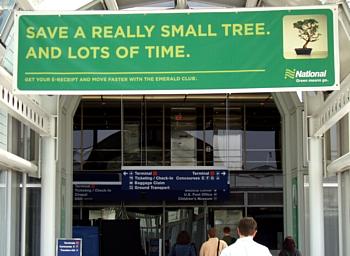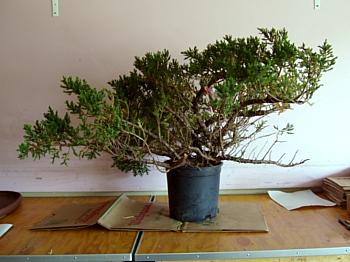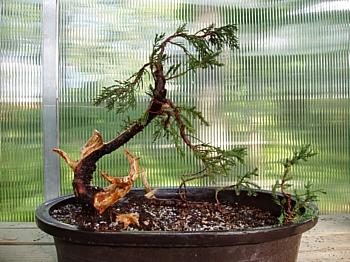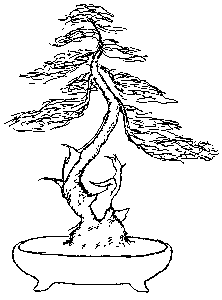
Larger version

An airport advertisement encourages passengers to save a bonsai. I was in transit to Springfield, Illinois to attempt to do just that.

Hello, demo tree. This nursery stock had a canopy of lush, healthy green foliage. My first job was to clean out all the dead foliage on this overgrown prostrata juniper.

Now I could see the structure of the tree. This unruly octopus sported a multitude of trunks. Unfortunately, they were lacking in taper and branching. Some had nice movement while others were uninterestingly straight. I think I spent more time cleaning and studying this material than conducting my demonstration. The objective was to find the bonsai style that would make the most of this challenging material. Some potential trunks had interesting movement but lacked branching and foliage.
In a perfect world, I would have trimmed back foliage and exposed the inner structure of the tree to encourage new branch growth closer to the base. Unfortunately, that would take a few years, and the club members watching this demo only had a few hours. So on to Plan B: I chose the trunk with the most interesting movement and greatest number of branches.
Much of this bush needed to be whacked off to find a bonsai. However, juniper wood is great for carving. The dead wood could give the tree character and perceived age.

Yikes! What have I done? There wasn't much left to this tree. But when turning a bush into a bonsai, you need to begin with the structure of the tree. Believe it or not, this was the beginning of a raft: one large tree on the left with several small trees on the raft to the right.
Unnecessary trunks and branches were trimmed to length, stripped of bark, and made ready for carving, tapering, and refinement. Some wire was put on the few branches that remained.
The natural flow of the large tree to the smaller trees was quite pleasing. The grand tree captured your attention; your eye then followed the flow to take in the entire composition.

Before repotting, the jin and shari (dead branches and trunk) were carved to give added movement and taper. The bark on the underside of the raft was stripped off to reveal the cambium layer. A rooting hormone was dusted onto the cambium to encourage root growth. The tree was wired into a deep growing pot.
For the next few years, as the raft roots develop, attention should be directed toward branch development.

This is how I envision the raft in a few years. The shallow tray is appropriate in size; the oval shape harmonizes with the trunk movement. Branches are more developed and the small trees mimic the shape and flow of the larger tree.

A girl needs choices... so here's another way to style the tree: lose the raft and create a dramatic informal upright. The size and shape of the pot would need to be adjusted to fit the tree. Because there are no branches on the lower trunk, the first two branches should be dropped down to bring foliage where needed.
In just a few hours, a bonsai emerged from the bush. The octopus was tamed, and its new owner was given two designs for future development. That was fun. Now the real work begins.
[ Top of page | Go back | Go forward | "Bush to Bonsai" contents | Site contents | Home | ]